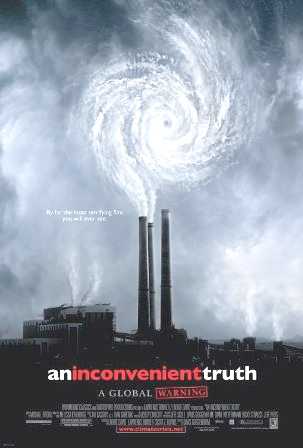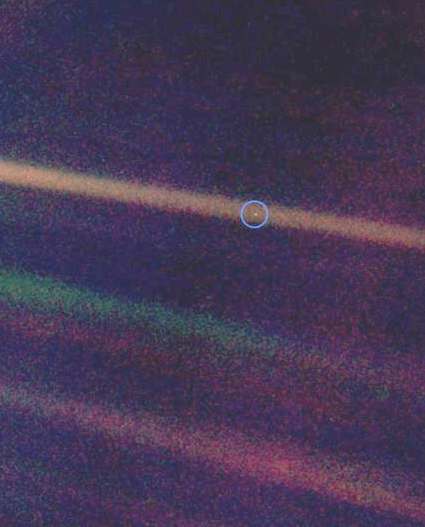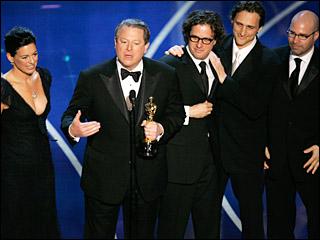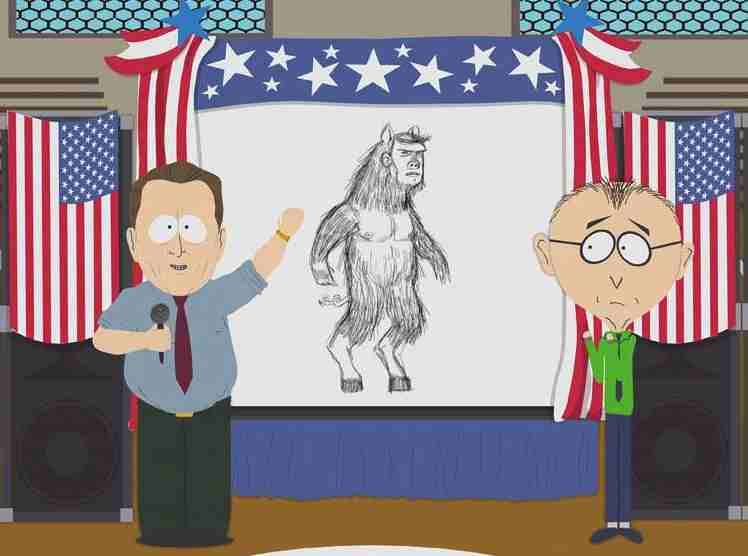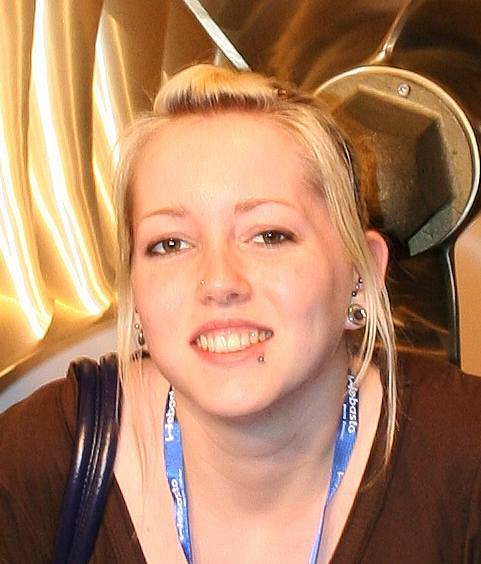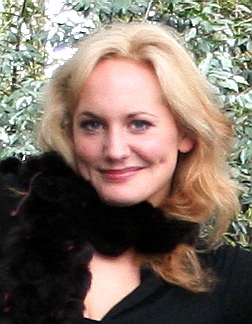|
AN INCONVENIENT TRUTH
|
|||||||||||||||||||||||||||||||||||||||||||||||||||||||||||||||||||||||||||
|
An Inconvenient Truth is an Academy Award-winning documentary film about climate change, specifically global warming, presented by former United States Vice President Al Gore and directed by Davis Guggenheim. A companion book authored by Gore has been on the paperback nonfiction New York Times bestseller list since June 11, 2006, reaching #1 on July 2, 2006.
The film premiered at the 2006 Sundance Film Festival and opened in New York and Los Angeles on May 24, 2006. Earning $49 million at the box-office, An Inconvenient Truth is the third highest-grossing documentary film to date in the United States after Fahrenheit 9/11 and March of the Penguins. The film's distributor, Paramount Classics, is donating 5% of the box office receipts and Gore is donating all of his proceeds from the film to the Alliance for Climate Protection (of which Gore is both founder and chairman). The film was released on DVD by Paramount Home Entertainment on November 21, 2006. An Inconvenient Truth was well received by film critics, scientists, and politicians and won two Academy Awards. It is also being used in school science curricula around the world. Global warming skeptics have criticized the film, calling it "exaggerated and erroneous".
An Inconvenient Truth DVD cover
Synopsis
“You look at that river gently flowing by. You notice the leaves rustling with the wind. You hear the birds; you hear the tree frogs. In the distance you hear a cow. You feel the grass. The mud gives a little bit on the river bank. It’s quiet; it’s peaceful. And all of a sudden, it’s a gear shift inside you. And it’s like taking a deep breath and going, "Oh yeah, I forgot about this." Al Gore in the opening monologue of An Inconvenient Truth
An Inconvenient Truth focuses on Al Gore and his travels in support of his efforts to educate the public about the severity of the climate crisis. Gore says, "I've been trying to tell this story for a long time and I feel as I've failed to get the message across." The film nearly follows a Keynote presentation (dubbed "the slideshow") that Gore presented throughout the world. It intersperses Gore's exploration of data and predictions regarding climate change and its potential for disaster with Gore's life story.
It weaves in events that changed his worldview, including his college education with early climate expert Roger Revelle at Harvard University, his sister's death from lung cancer, and his young son's near-fatal car accident. Throughout the film, Gore makes comments regarding his loss to George W. Bush in the 2000 United States presidential election. For comic effect, Gore also uses a clip from the Futurama episode "Crimes of the Hot" to explain global warming.
In the slideshow Gore reviews the scientific opinion on climate change, discusses the politics and economics of global warming, and describes the consequences he believes global climate change will produce if the amount of human-generated greenhouse gases are not significantly reduced in the very near future. A centerpoint of the film is his examination of the annual temperature and CO2 levels for the past 650,000 years in Antarctic ice core samples.
The film includes many segments intended to refute critics who say that global warming is unproven or that warming will be insignificant. For example, Gore discusses the possibility of the collapse of a major ice sheet in Greenland or in West Antarctica, either of which could raise global sea levels by approximately 20 feet (6m), flooding coastal areas and producing 100 million refugees. Meltwater from Greenland, because of its lower salinity, could then halt the Gulf Stream current and quickly trigger dramatic local cooling in Northern Europe. The documentary ends with Gore arguing that if appropriate actions are taken soon, the effects of global warming can be successfully reversed by releasing less CO2 and planting more vegetation to consume existing CO2. Gore calls upon his viewers to learn how they can help him in these efforts.
Gore's book of the same title was published concurrently with the theatrical release of the documentary. The book contains additional information, scientific analysis, and Gore's commentary on the issues presented in the documentary. A 2007 documentary entitled An Update with Former Vice President Al Gore features Gore discussing additional information that came to light after the film was completed, such as Hurricane Katrina.
The Pale Blue Dot, a Voyager 1 photo showing Earth (circled) as a single pixel from 4 billion miles (6.4 billion kilometres) away, is featured in An Inconvenient Truth. Al Gore points out that all of human history has happened on that tiny pixel, which is our only home.
Scientific basis
Gore's claim is that global warming and cooling is real and largely human-caused. Gore presents specific data that supports the film's thesis, including:
The Associated Press contacted more than 100 climate researchers and questioned them about the film's veracity. All 19 climate scientists who had seen the movie said that Gore conveyed the science correctly. In contrast, the U.S. Senate Committee on Environment and Public Works, at the time chaired by Republican Senator Jim Inhofe issued a press release criticizing this article. Inhofe's statement that "global warming is the greatest hoax ever perpetrated on the American people" appears in the film.
Origins
Gore became intrigued by the topic of global warming when he took a course at Harvard University with Professor Roger Revelle, one of the first scientists to measure carbon dioxide in the atmosphere. Later, when Gore was in Congress, he initiated the first congressional hearing on the subject, brought in climate scientists and began talking to politicians about the issue. He thought that once legislators heard the compelling evidence, they would be driven to action; ultimately, though, the process was a slow one. Gore's 1992 book, Earth in the Balance, dealing with a number of environmental topics, reached the New York Times bestseller list.
As Vice President during the Clinton Administration, Gore pushed for the implementation of a carbon tax to modify incentives to reduce fossil fuel consumption causing fossil fuel to last longer and thereby decrease emission of greenhouse gases in the short term but not long term; it was partially implemented in 1993. He helped broker the 1997 Kyoto Protocol, an international treaty designed to curb greenhouse gas emissions. However, it was not ratified in the United States due to opposition, in the Senate. The primary objections stemmed from the exemptions the treaty gives to China and India, whose industrial base and carbon footprint are growing rapidly, and fears that the exemptions would lead to further trade imbalances and offshoring arrangement with those countries.
Gore also supported the funding of a satellite called Triana, to increase awareness of environmental issues and to take the first direct measurements of how much sunlight is reflected from the Earth. During his 2000 Presidential Campaign, Gore ran, in part, on a pledge to ratify the Kyoto Protocol.
After his defeat in the 2000 presidential election to George W. Bush, Gore returned his focus to the topic. He edited and adapted a slideshow he had compiled years earlier, and began featuring the slideshow in multimedia presentations on global warming across the U.S. and around the world. At the time of the film, Gore estimated he had shown the presentation more than one thousand times.
Producers Laurie David and Lawrence Bender saw Gore's slide show in New York City after the 2004 premiere of The Day After Tomorrow. Inspired, they met with director Davis Guggenheim about the possibility of making the slide show into a movie. Guggenheim, who was skeptical at first, later saw the presentation for himself, stating that he was "blown away," and "left after an hour and a half thinking that global warming [was] the most important issue. . . . I had no idea how you’d make a film out of it, but I wanted to try," he said.
Reception
Box office
The film opened in New York City and Los Angeles on May 24, 2006. On Memorial Day weekend, it grossed an average of $91,447 per theater, the highest of any movie that weekend and a record for a documentary, though it was only playing on four screens at the time.
At the 2006 Sundance Film Festival, the movie received three standing ovations. It was also screened at the 2006 Cannes Film Festival and was the opening night film at the 27th Durban International Film Festival on June 14, 2006. An Inconvenient Truth was the most popular documentary at the 2006 Brisbane International Film Festival.
The film has grossed over $24 million in the U.S. and over $49 million worldwide as of June 3, 2007, making it the third-highest-grossing documentary in the U.S. to date (after Fahrenheit 9/11 and March of the Penguins).
Al Gore has stated, "Tipper and I are devoting 100 percent of the profits from the book and the movie to a new bipartisan educational campaign to further spread the message about global warming." Paramount Classics is committing 5% of their domestic theatrical gross for the film to a new bipartisan climate action group, Alliance for Climate Protection, dedicated to awareness and grassroots organizing.
Reviews
The film received a positive reaction from critics. It garnered a "certified fresh" 93% rating at Rotten Tomatoes (as of May 21, 2007), with a 94% rating from the "Cream of the Crop" reviewers. Film critics Roger Ebert and Richard Roeper gave the film "two thumbs up". Ebert wrote: "In 39 years, I have never written these words in a movie review, but here they are: You owe it to yourself to see this film. If you do not, and you have grandchildren, you should explain to them why you decided not to."
Journalist Ronald Bailey argued in the libertarian magazine Reason that although "Gore gets [the science] more right than wrong," he exaggerates the risks.
Al Gore during the acceptance speech for An Inconvenient Truth with other members of the crew
Awards
The film has received a number of awards worldwide.
Best Documentary:
Best Non-Fiction:
Political response
The documentary has been generally well-received politically in many parts of the world and is credited for raising further awareness of global warming internationally, prompting calls for more government action in regard to the climate. Despite its success, some political leaders are less keen on embracing the film as a matter-of-fact necessity. Several colleges and high schools have begun to use the film in science curricula, though at least one US school district has put restrictions on its use in the classroom.
Government
Education
Other
Criticism
Academia
Richard S. Lindzen, an atmospheric physicist at MIT and anthropogenic global warming skeptic, wrote in a June 26, 2006 op-ed in the Wall Street Journal that Gore was using a biased presentation to exploit the fears of the public for his own political gain. Roy Spencer, a principal research scientist at the Earth System Science Center of the University of Alabama in Huntsville, wrote an open letter to Gore criticizing his presentation of climate science in the film, asserting that the Arctic had a similar temperature in the 1930s before the mass emissions of carbon dioxide began. Former University of Winnipeg geography professor Dr. Timothy F. Ball rejected Gore’s claim that there has been a sharp drop-off in the thickness of the Arctic ice cap since 1970, stating that the data was taken only from an isolated area of the Arctic and during a specific cooling period.
Media
A March 13, 2007 article in The New York Times reported on concerns among some scientists about the tone and the accuracy of the film, noting that they "argue that some of Mr. Gore’s central points are exaggerated and erroneous". Gore's discussion of a rise in sea level of up to 20 feet is contrasted with a report from the Intergovernmental Panel on Climate Change (IPCC), which predicts a maximum rise of 23 inches excluding non-linear effects on ice sheets; although that too discusses the possibilities of higher rises if the ice sheets melt. The article also states that "a report last June by the National Academies seemed to contradict Mr. Gore’s portrayal of recent temperatures as the highest in the past millennium." The article quotes both defenders and critics of the film; Gore responds that scientists may disagree with him on some details, "but we do agree on the fundamentals."
An April 19, 2007 article in Telegraph.co.uk reported on concerns among parents who claim that the film is "inaccurate and politically motivated" and are "threatening a legal challenge over the Government's decision to send it to every secondary school." Parents claim that "the circulation of the film by the Government amounts to political indoctrination and is in breach of the Education Act 2002."
The Great Global Warming Swindle
The documentary film The Great Global Warming Swindle, broadcast on Channel 4 in the UK on March 8, 2007, brought together skeptical scientists who disagree with the prevailing consensus regarding human-caused global warming. Among other claims, the film states that Gore has misrepresented the data in An Inconvenient Truth, and that the actual relationship between carbon dioxide and the temperature is the other way round (that is, rise in temperature preceded an increase in carbon dioxide in the ice core samples). Several of the film's claims have been disputed by scientists and scientific bodies such as John T. Houghton, the British Antarctic Survey, Eigil Friis-Christensen and the Royal Society. Global warming skeptic Fred Singer wrote that the documentary is "devastating" to Gore's movie: "...The Great Global Warming Swindle is based on sound science by recording the statements of real climate scientists. An Inconvenient Truth mainly records a politician."
South Park parody of An Inconvenient Truth with Al Gore
Influences on popular culture
" Gore and a fringe group of radical liberals known as "scientists" believe that the earth is being damaged by man-made carbon dioxide. Well, bad-mouth humanity all you want, but diss carbon dioxide and the Competitive Enterprise Institute is likely to open up a can of public service advertising on your ass [Institute's ads are shown onscreen]. I know what you're driving at, but I really don't think science and liberals are going to outlaw breathing. "
References
Madison Ave. Warms to Climate Change
Al Gore has helped create a climate in which his business is hotly contested. Photo Credit: Nancy Kaszerman
http://adage.com/article?article_id=120088
Matthew Creamer & Brooke Capps
SAILING EVENTS - MEDIA EXPOSURE TABLE
Once advertising your product with an association to an alternative energy project may have been unthinkable for upsetting the airlines and auto makers. Not any more according to Advertising Age:
See the table of media returns below for adventure sailing projects. They are all clean. The last entry is an alternative energy sailing project - a non-polluting electric boat. Sponsors, what are you waiting for?
ONLINE AD SPENDING HITS NEW HIGH
POTENTIAL SPONSORS CLICK HERE TO FIND OUT MORE
Solar Navigator represents a unique opportunity for a company or companies with similar ideals to reap significant media coverage cost effectively via this environmentally friendly robot boat designed to set a historical world first unmanned circumnavigation record.
Where the subjects of pollution, global warming and renewable energy are hot topics, a team of engineers will attempt to set a world first sailing record with a cutting edge trimaran design. After the navigation event, the robot ship will make scheduled media stops at key locations, to suit sponsors and generate a media following designed to maximise exposure for project partners.
To find out more about this exciting world first and see how Solar Navigator could benefit your business please contact our marketing department :-
By Post:
World Autonomous Solar Challenge Max
Energy Limited Herstmonceux United Kingdom
By
Email:
Or leave a message: 0044 1323 831727
Interested companies and investors may request our Business Plan, subject to completion of a Non Disclosure Agreement.
To seek, teach, and communicate scientific understanding of the oceans, atmosphere, Earth, and other planets for our society and the environment.
The ultimate Robot Boat. Solarnavigator uses an advanced SWASSH hull as the platform to mount the world's first autonomous circumnavigation. A successful expedition could pave the way for improved safety at sea.
|
|||||||||||||||||||||||||||||||||||||||||||||||||||||||||||||||||||||||||||
| This website is copyright © 1991- 2013 Electrick Publications. All rights reserved. The bird logo and names Solar Navigator and Blueplanet Ecostar are trademarks ™. The Blueplanet vehicle configuration is registered ®. All other trademarks hereby acknowledged and please note that this project should not be confused with the Australian: 'World Solar Challenge'™which is a superb road vehicle endurance race from Darwin to Adelaide. Max Energy Limited is an educational charity working hard to promote world peace. | |||||||||||||||||||||||||||||||||||||||||||||||||||||||||||||||||||||||||||
|
AUTOMOTIVE | BLUEPLANET BE3 | ELECTRIC CARS | ELECTRIC CYCLES | SOLAR CARS | SOLARNAVIGATOR |
